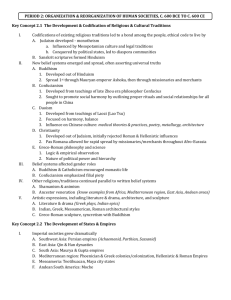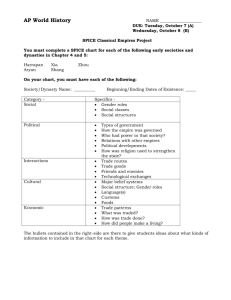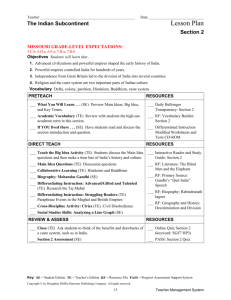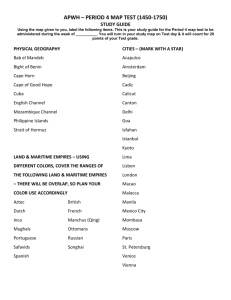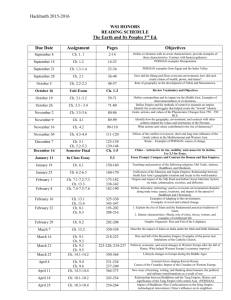AP WORLD REVIEW TERMS/VOCABULARY FOR COLLEGE
advertisement
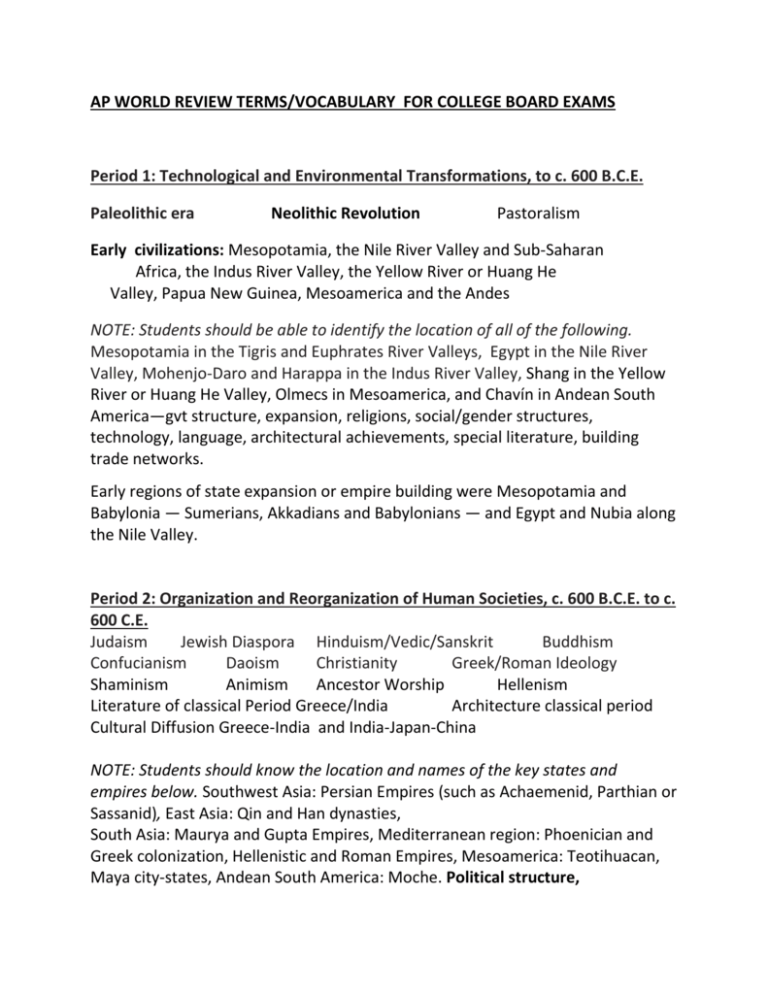
AP WORLD REVIEW TERMS/VOCABULARY FOR COLLEGE BOARD EXAMS Period 1: Technological and Environmental Transformations, to c. 600 B.C.E. Paleolithic era Neolithic Revolution Pastoralism Early civilizations: Mesopotamia, the Nile River Valley and Sub-Saharan Africa, the Indus River Valley, the Yellow River or Huang He Valley, Papua New Guinea, Mesoamerica and the Andes NOTE: Students should be able to identify the location of all of the following. Mesopotamia in the Tigris and Euphrates River Valleys, Egypt in the Nile River Valley, Mohenjo-Daro and Harappa in the Indus River Valley, Shang in the Yellow River or Huang He Valley, Olmecs in Mesoamerica, and Chavín in Andean South America—gvt structure, expansion, religions, social/gender structures, technology, language, architectural achievements, special literature, building trade networks. Early regions of state expansion or empire building were Mesopotamia and Babylonia — Sumerians, Akkadians and Babylonians — and Egypt and Nubia along the Nile Valley. Period 2: Organization and Reorganization of Human Societies, c. 600 B.C.E. to c. 600 C.E. Judaism Jewish Diaspora Hinduism/Vedic/Sanskrit Buddhism Confucianism Daoism Christianity Greek/Roman Ideology Shaminism Animism Ancestor Worship Hellenism Literature of classical Period Greece/India Architecture classical period Cultural Diffusion Greece-India and India-Japan-China NOTE: Students should know the location and names of the key states and empires below. Southwest Asia: Persian Empires (such as Achaemenid, Parthian or Sassanid), East Asia: Qin and Han dynasties, South Asia: Maurya and Gupta Empires, Mediterranean region: Phoenician and Greek colonization, Hellenistic and Roman Empires, Mesoamerica: Teotihuacan, Maya city-states, Andean South America: Moche. Political structure, social/gender organization, religion, trade networks, expansion, labor systems, resource issues/environmental issues, external issues/nomadic incursions, architecture of the above civilizations. Role of major cities: Persepolis, Chang’an, Pataliputra, Athens, Carthage, Rome, Alexandria, Constantinople or Teotihuacan). Emergence of Transregional Networks of Communication and Exchange-Students should know how factors, including the climate and location of the routes, the typical trade goods, and the ethnicity of people involved, shaped the distinctive features of the following trade routes. Eurasian Silk Roads, TransSaharan caravan routes, Indian Ocean sea lanes, One of the following: Mediterranean sea lanes; American trade routes; or the north-south Eurasian trade routes linking the Baltic region, Constantinople and Central Asia. New technologies (such as yokes, saddles or stirrups) permitted the use of domesticated pack animals (such as horses, oxen, llamas or camels) to transport goods across longer routes. Innovations in maritime technologies (such as the lateen sail or dhow ships), as well as advanced knowledge of the monsoon winds, stimulated exchanges along maritime routes from East Africa to East Asia. Period 3: Regional and Trans-regional Interactions, c. 600 C.E. to c. 1450 Existing trade routes, including the Silk Roads, the Mediterranean Sea, TransSaharan and the Indian Ocean basins, flourished and promoted the growth of powerful new trading cities (such as — to mention just a few — Novgorod, Timbuktu, Swahili city-states, Hangzhou, Calicut, Baghdad, Melaka and Venice, or in the Americas, Tenochtitlan or Cahokia). Transportation and commercial technologies, including caravan organization (such as caravanserai or camel saddles); use of the compass, astrolabe and larger ship designs in sea travel; and new forms of credit and monetization (such as bills of exchange, credit, checks or banking houses). New trading organizations (such as the Hanseatic League) and new state- sponsored commercial infrastructures like the Grand Canal in China. Expansion of existing empires —China, the Byzantine Empire and Caliphates — new empires (such as the Mongols) Some migrations had a significant environmental impact, including the Bantuspeaking of Sub-Saharan Africa, and the maritime migrations of the Polynesian. Emergence of new languages (spread of Bantu languages, the new language of Swahili in East African coastal areas, or the spread of Turkic and Arabic languages). Spread of Islam Writings of Ibn Battuta, Marco Polo or Xuanzang Cross-cultural interactions--diffusion of literary, artistic and cultural traditions (influence of Neo-Confucianism and Buddhism in East Asia, Hinduism and Buddhism in Southeast Asia, Islam in Sub-Saharan Africa and Southeast Asia or Toltec/Mexica and Inca traditions in Mesoamerica and Andean America Diffusion of scientific and technological traditions (influence of Greek and Indian mathematics on Muslim scholars, the return of Greek science and philosophy to Western Europe via Muslim al-Andalus in Iberia or the spread of printing and gunpowder technologies from East Asia into the Islamic empires and Western Europe). Black Death Spread of food/crops Reconstituted governments, including the Byzantine Empire and the Chinese dynasties — Sui, Tang and Song—Structures, religion, architecture, trade, expansion New forms of governance emerged (such as the Abbasids, the Muslim Iberia or the Delhi Sultanates), the Mongol Khanates and city-states (such as in the Italian peninsula, East Africa or Southeast Asia Maya region, imperial systems were created by the Mexica (“Aztecs”) and Inca— govt., economy, trade, social systems, architecture, religion, technology, etc. Agricultural production due to technological innovations (such as Champa rice varieties, the chinampa field systems, waru waru agricultural techniques in the Andean areas, improved terracing techniques or the horse collar). Little Ice Age Invasions Mita serfdom spread of disease guilds Revolutions spread of religions NOTE: Students should be able to explain the cultural, religious, commercial and governmental function of at least two major cities. Period 4: Global Interactions, c. 1450 to c. 1750 Intensification of all existing regional trade networks regions of the Indian Ocean, Mediterranean, Sahara and overland Eurasia. European technological developments in cartography and navigation, and included the production of new tools (such as the astrolabe or revised maps), innovations in ship designs (such as caravels), and an improved understanding of global wind and currents patterns Ming Admiral Zheng He Know the European Explorers!! Trade in Africa—slave trade in west, Indian ocean trade in East Silver flow-impact on global economy mercantilism joint-stock companies Atlantic system Columbian Exchange Spread of Islam, Christianity—impact on Native Americans , Buddhism, Sikhism-fusion of Islam and Hinduism Renaissance Art/literature Japanese art/literature art Middle East Shakespeare Cervantes Sundiata Journey to the West Kabuki Atlantic Slave Trade—impact on Africans in North and South America Russian serfdom encomienda system Mita system Formation of new political and economic elites (such as the Manchus in China, Creole elites in Spanish America, European gentry or urban commercial entrepreneurs in all major port cities in the world Zamindars in the Mughal Empire daimyo in Japan the nobility in Europe changes in gender roles and demographics with slave trade Social castas in Latin America—peninsulares, mestizo, mulatto or Creole European notions of divine right, the Safavid use of Shiism, the Mexica or Aztec practice of human sacrifice, the Songhai promotion of Islam or the Chinese emperors’ public performance of Confucian rituals) to legitimize their rule. States treatment of different ethnic and religious (such as the Ottoman treatment of non-Muslim subjects, Manchu policies toward Chinese or the Spanish creation of a separate “República de Indios” Development of military professionals (such as the Ottoman devshirme, Chinese examination system or salaried samurai Europeans established new trading-post empires in Africa and Asia Land empires, including the Manchus, Mughals, Ottomans and Russians, expanded dramatically in size. Thirty Years War Ottoman-Safavid conflict Bread Riots Period 5: Industrialization and Global Integration, c. 1750 to c. 1900 Agricultural Revolution Industrial Revolution Urbanization Development of Technology/factory systems, energy sources Spread of Industrial revolution Second Industrial Revolution Need for resources/colonies/markets Adam Smith Development of financial systems Karl Marx John Stuart Mill Labor movements New social, gender, and family roles State-sponsored industrialization (economic reforms of Meiji Japan, the development of factories and railroads in Tsarist Russia, China’s SelfStrengthening Movement or Muhammad Ali’s development of a cotton textile industry in Egypt) Settler colonies (such as the British in southern Africa, Australia and New Zealand; or the French in Algeria Meiji Japan Creation of Imperial Empires Spread of nationalism Anti-imperial resistance led to the establishment of independent states in the Balkans; semi-independence in Egypt, French and Italian colonies in North Africa; or later British influence in Egypt New states (such as the Cherokee Nation, Siam, Hawai’i or the Zulu Kingdom) developed on the edges of an empire Know your enlightenment thinkers/impact they had Wahhabi rebellion against the Ottomans challenge of the Marathas to the Mughal Sultans American/Latin American rebellions/revolutions Indian Revolt of 1857 the Mahdist Revolt Taiping Rebellion Ghost Dance Tanzimat movement Boxer Rebellion Xhosa Cattle-Killing Movement Self-Strengthening Movement Reform of Bismarckian Pension Systems liberalism socialism communism women’s suffrage Technology/medical research Transportation/migration/urbanization Medial innovations green revolution Energy technologies global warming Environmental issues diseases of poverty military technology WW1 and beyond birth control impact collapse of empires colonial resistance/independence nationalist leaders- Mohandas Gandhi, Ho Chi Minh or KwameNkrumah Regional, religious and ethnic movements (such as that of Muhammad Ali Jinnah, the Quebecois separatist movement or the Biafra secessionist movement Transnational movements (such as communism, Pan-Arabism or Pan-Africanism Transnational movements (such as communism, Pan-Arabism or Pan-Africanism Genocide (such as Armenia, the Holocaust, Cambodia or Rwanda) and the displacement of peoples resulting in refugee populations (such as the Palestinians or Darfurians WW1 and WW2—total war cold war competitions Nato v.s. Warsaw collapse of Russia Groups and individuals challenged the many wars of the century (such as Picasso in his Guernica, the antinuclear movement during the Cold War or Thich Quang Duc by self-immolation), and some promoted the practice of nonviolence (such as Tolstoy, Gandhi or Martin Luther King) as a way to bring about political change Non-Aligned Movement Tiananmen Square protesters Anti-Apartheid Movement IRA, ETA or Al-Qaeda) use of terrorism military dictatorship in Chile, Spain and Uganda; the United States’ promotion of a New World Order after the Cold War; or the buildup of the “military-industrial complex” and arms trading League of Nations United Nations IMF World Bank WTO UNICEF Red Cross Amnesty International Doctors Without Borders WHO European Union NAFTA ASEAN Mercosur U.N. Universal Declaration of Human Rights, women’s rights or the end of the White Australia Policy new cultural identities (such as negritude) and exclusionary reactions (such as xenophobia, race riots or citizenship restrictions new forms of spirituality (such as New Age Religions, Hare Krishna or Falun Gong) and apply them to political issues (such as fundamentalist movements or Liberation Theology World Cup Soccer the Olympics cricket reggae Bollywood

